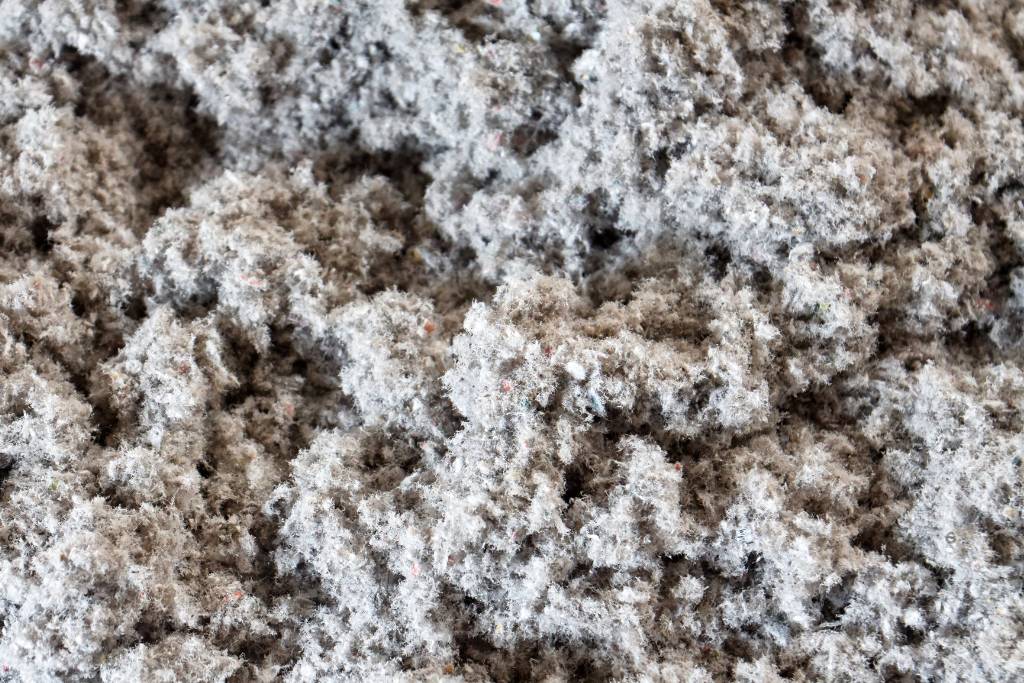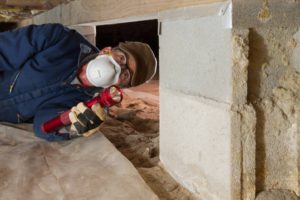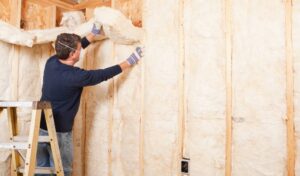Definition of cellulose insulation
Cellulose insulation is a type of insulation material made from plant fibers, typically recycled paper. Its purpose is to reduce heat loss and noise transmission in buildings, providing energy efficiency and soundproofing properties.
The history of cellulose insulation can be traced back to its origins as a plant-based insulation material, with early use dating back to ancient times. However, its modern usage can be attributed to the increasing demand for energy-efficient building materials following the 1973 oil embargo.
Cellulose insulation is composed of approximately 80-85% recycled paper fibers, which are treated with fire-retardant chemicals to meet safety standards. This composition makes it an environmentally friendly option for insulation.
In conclusion, cellulose insulation has a long history as a plant-based insulation material, and its role in improving energy efficiency and reducing heat loss has led to its increasing demand in building construction. This makes it an important component in sustainable and eco-friendly building practices.
Importance of insulation in homes
Insulation plays a crucial role in maintaining a comfortable interior, reducing sound transmission, and saving energy in homes. In terms of comfort, insulation helps to regulate indoor temperatures by minimizing heat transfer, thus keeping the home warm in winter and cool in summer. This not only ensures a pleasant living environment but also reduces the need for excessive use of heating or cooling systems. Additionally, insulation contributes to sound reduction by absorbing and blocking noise from outside, which is particularly beneficial for homes located in noisy areas.
Moreover, proper insulation significantly reduces energy consumption and utility bills by minimizing heat loss and gain through walls, floors, and ceilings. This not only benefits homeowners by lowering their energy costs but also contributes to environmental conservation by reducing the overall energy demand.
Different types of insulation, such as batt insulation, polyurethane foam, and blown-in insulation, offer various benefits and are suitable for different areas of the home. Batt insulation is comprised of fiberglass or mineral wool and is commonly used in walls and attics. Polyurethane foam insulation is known for its high energy efficiency and is typically applied to walls, roofs, and floors. Blown-in insulation, made of cellulose or fiberglass, is perfect for filling gaps and cavities in walls and attics. These options provide homeowners with the flexibility to choose the most suitable type of insulation based on their specific needs, ensuring a comfortable and energy-efficient living space.
Benefits of Cellulose Insulation
Cellulose insulation is an environmentally friendly and energy-efficient option for insulating homes and buildings. Made from recycled paper products, cellulose insulation offers a number of benefits that make it an attractive choice for those looking to improve the energy efficiency and comfort of their spaces. This type of insulation is known for its cost-effectiveness, as well as its ability to reduce energy consumption and lower utility bills. In addition, cellulose insulation is fire-resistant and provides excellent soundproofing, making it a versatile choice for various types of construction projects. With its sustainable materials and impressive performance, cellulose insulation is a popular option for those looking to improve the insulation of their homes and reduce their environmental impact.
Energy Efficiency
Energy efficiency in buildings is crucial for reducing energy consumption, lowering utility costs, and minimizing environmental impact. Insulation materials play a significant role in improving energy efficiency by reducing heat transfer and minimizing the need for heating and cooling.
Bio-based materials, such as cellulose insulation, are sustainable options that can contribute to energy efficiency in buildings. Cellulose insulation is made from recycled paper and has a high R-value, effectively reducing heat transfer and preventing energy loss. Additionally, the production of cellulose insulation requires less energy compared to traditional insulation materials, further enhancing its energy-saving benefits.
Moisture buffering, a feature of some bio-based insulation materials, can have direct and indirect effects on heating load and energy consumption. By absorbing and releasing moisture, these materials can help stabilize indoor humidity levels, reducing the need for energy-consuming dehumidification or humidification systems. This, in turn, can lead to lower energy consumption for heating and cooling.
In conclusion, energy efficiency in buildings is crucial for reducing energy consumption and environmental impact. Insulation materials, particularly bio-based options like cellulose insulation, play a significant role in improving energy efficiency and can have additional benefits, such as moisture buffering, that further contribute to energy savings.

Reducing heat transfer
One method for reducing heat transfer in buildings is through the use of smart bio-based materials. These materials, such as common reed and other green materials with low environmental impact and thermoacoustic insulation properties, can effectively minimize heat transfer through walls, roofs, and floors. These materials can be used as insulation to reduce the amount of heat that enters or escapes a building, therefore decreasing the need for excessive heating or cooling.
Additionally, the hygroscopic behavior of bio-based materials, the ability to absorb and release moisture from the surrounding air, plays a significant role in reducing energy consumption in buildings. This behavior helps regulate indoor humidity levels, which in turn can affect the heating load. The moisture buffering capacity of these materials can directly impact energy use by stabilizing indoor temperature fluctuations and indirectly affect energy consumption by reducing the need for additional heating or cooling.
Moreover, latent-heat exchanges, such as those involved in the evaporation and condensation of moisture, also have an impact on heating load in buildings. By utilizing bio-based materials with hygroscopic properties, buildings can benefit from the passive regulation of latent-heat exchanges, further reducing the overall heating load and energy consumption. By incorporating these methods and techniques, buildings can efficiently minimize heat transfer and optimize energy usage.
Minimizing heat loss and gain
When it comes to building and maintaining a comfortable and energy-efficient environment, minimizing heat loss and gain is crucial. By reducing the amount of heat that escapes or enters a building, whether through insulation, ventilation, or other means, you can significantly decrease the energy needed for heating and cooling. This not only helps to lower energy costs, but also reduces a building’s overall carbon footprint. From understanding the principles of heat transfer to implementing effective insulation and ventilation strategies, minimizing heat loss and gain is essential for creating sustainable and comfortable indoor environments. In this article, we will explore various methods and techniques for achieving this goal, offering practical and cost-effective solutions for homeowners and businesses alike. Whether you’re looking to improve the efficiency of your current space or planning a new construction project, the following headings will provide valuable insights and actionable tips for minimizing heat loss and gain.
Environmental Sustainability
Smart bio-based materials like cellulose insulation and common reed have a significant impact on reducing buildings’ energy use and promoting environmental sustainability. By using these materials in construction, potential energy savings are realized through reduced heating and cooling energy consumption. Additionally, these materials are effective in achieving a healthy level of humidity, which further contributes to energy efficiency.
Cellulose insulation, made from recycled paper products, provides excellent thermal performance, reducing the need for energy-intensive heating and cooling systems. Common reed, a natural and renewable material, offers similar benefits by providing insulation and moisture regulation, reducing the reliance on artificial climate control.
Furthermore, the advantages of moisture buffering and latent-heat exchanges in these materials contribute to energy efficiency in buildings. By absorbing and releasing moisture, smart bio-based materials can help maintain a stable indoor climate, reducing the energy required for dehumidification and air conditioning.
Overall, the use of smart bio-based materials in construction not only supports energy efficiency but also brings about environmental benefits through the reduction of energy consumption and the promotion of sustainable building practices. By incorporating these materials, buildings can significantly reduce their environmental impact and contribute to a more sustainable future.
Use of recycled materials
in sustainable building practices is a crucial step towards reducing the environmental impact of construction. By incorporating recycled materials, such as post-consumer waste newsprint in cellulose insulation, builders are able to minimize the demand for virgin resources and divert waste from landfills. This contributes to a more sustainable and circular economy.
In relation to building energy use, the use of recycled materials can significantly reduce heating and cooling energy consumption. Hygroscopic materials, such as cellulose insulation, have the ability to absorb and release moisture, helping to regulate indoor humidity levels. This, in turn, reduces the reliance on mechanical heating and cooling systems, leading to lower energy usage and cost savings.
Cellulose insulation, with its high recycled content, provides excellent thermal performance and contributes to a healthier indoor environment. It also has a low environmental impact, as it is produced from renewable resources and does not contain harmful chemicals. By choosing cellulose insulation, builders can enhance the sustainability of their projects while also reaping the benefits of reduced energy consumption and cost savings.
Reduced carbon footprint
Reducing carbon footprint is crucial in combating climate change and preserving the environment for future generations. By making conscious choices to reduce our carbon emissions, we can collectively make a positive impact on the planet. From making changes in our daily habits to advocating for sustainable practices on a larger scale, there are various ways to minimize our carbon footprint and contribute to a more sustainable future. Let’s explore some practical steps and initiatives that can help us lower our carbon footprint and work towards a greener and cleaner planet.
Soundproofing Properties
Cellulose insulation is known for its excellent soundproofing properties due to its mass and damping capabilities. The density of cellulose insulation helps to reduce noise by absorbing and dampening sound waves, making it an effective barrier for preventing sound from traveling through walls and between floor levels.
Compared to fiberglass insulation, cellulose has a higher density, which allows it to provide better soundproofing. The mass of cellulose insulation helps to block and absorb sound, reducing the level of noise transmission through walls and between different floors of a building. Additionally, the damping properties of cellulose insulation help to dissipate sound energy, further reducing the impact of noise.
Overall, cellulose insulation is an effective solution for soundproofing as it provides greater mass and damping capabilities compared to fiberglass, making it an ideal choice for reducing noise transmission within a building.
Noise reduction within the home
In a world filled with constant noise, finding ways to reduce the amount of it within our homes can greatly contribute to a peaceful and comfortable living environment. Whether it’s from outside traffic, neighbors, or even the appliances within our own home, noise reduction techniques can help to create a more serene and tranquil space for relaxation and focus. Let’s explore some effective methods for reducing noise within the home.
Soundproofing Materials
Installing soundproofing materials such as acoustic panels, soundproof curtains, and soundproof insulation can significantly reduce the amount of noise that enters or leaves the home. These materials work by absorbing or blocking sound waves, creating a quieter indoor environment.
Seal Gaps and Cracks
Small openings in windows, doors, and walls can allow noise to easily permeate into the home. By sealing these gaps and cracks with weather stripping, caulk, or draft stoppers, homeowners can effectively reduce the amount of noise that enters the home from outside.
White Noise Machines
Using white noise machines or fans can help to mask unwanted noise by providing a constant, soothing sound. This can be particularly helpful for light sleepers or in areas with consistent background noise.
Rearranging Furniture
Strategically rearranging furniture within the home can help to absorb and minimize noise. Placing bookshelves, curtains, and rugs in noise-prone areas can help to dampen sound and create a quieter atmosphere.
Fire Resistance
Cellulose insulation is known for its excellent fire resistance properties, making it a popular choice for insulating homes and buildings. When treated with borates, cellulose insulation becomes a Class I fire retardant, the highest level of fire resistance classification. Borates act as a natural fire retardant by interfering with the combustion process, making it difficult for fire to spread.
To demonstrate the fire-retarding capacity of cellulose insulation treated with borates, a blowtorch can be used to apply direct flame to the insulation. Remarkably, the insulation will resist catching fire and will only char on the surface. Another impressive demonstration involves placing a penny on top of the insulation and applying a blowtorch to it. The cellulose insulation will prevent the penny from melting, showcasing its effectiveness in protecting materials from intense heat.
One of the key advantages of using borates as a fire retardant in cellulose insulation is its safety rating and non-toxic nature. Borates are environmentally friendly and do not produce harmful fumes when exposed to fire. This makes cellulose insulation a safe and sustainable choice for both residential and commercial applications.
In summary, cellulose insulation treated with borates as a Class I fire retardant offers exceptional fire resistance while being safe and non-toxic, making it a reliable option for building insulation needs.

Fire retardant additives in cellulose insulation
There are several common types of fire retardant additives used in cellulose insulation, including borates, ammonium sulfate, and aluminum hydroxide. Borates are effective in preventing the spread of fire by releasing water vapor when exposed to high temperatures. Ammonium sulfate works by releasing ammonia and forming a protective char layer when heated. Aluminum hydroxide works as a heat sink, absorbing and dissipating heat to prevent ignition. These additives are incorporated into the manufacturing process of cellulose insulation by mixing them with the pulp during production to ensure even distribution throughout the material.
Using fire retardant additives in cellulose insulation is essential for meeting building codes and ensuring the safety of the home. These additives help to minimize the risk of fire hazards by slowing down the spread of flames and reducing the potential for ignition. Additionally, using fire retardant additives can provide peace of mind for homeowners, knowing that their insulation has an added layer of protection against fire. In conclusion, the properties and effectiveness of fire retardant additives in cellulose insulation play a crucial role in safeguarding homes and meeting safety standards.
Types of Cellulose Insulation
Cellulose insulation is a popular choice for homeowners looking to improve the energy efficiency of their homes. Made from recycled paper products, cellulose insulation is not only eco-friendly but also an effective insulator. There are several different types of cellulose insulation available, each with its own unique characteristics and benefits. From loose-fill to dense pack to spray-applied, the different types of cellulose insulation offer versatility to accommodate various insulation needs. Understanding the differences between these types can help homeowners make an informed decision when choosing the best option for their home. Let’s explore the various types of cellulose insulation and their advantages.
Loose-Fill Cellulose Insulation
Loose-fill cellulose insulation offers numerous benefits, including its eco-friendly nature, fire resistance, and ability to reduce energy costs. It is commonly used in retrofitting old homes due to its ability to fill gaps and cavities, providing efficient and effective insulation.
The history of loose-fill cellulose insulation dates back to its early use in Thomas Jefferson’s plantation in Virginia. However, its popularity surged following the 1973 oil embargo, as it became a popular alternative to traditional insulation materials.
The material used in making loose-fill cellulose insulation primarily consists of recycled newspaper, treated with fire retardant chemicals. However, concerns arose in the industry regarding the chemicals used in the insulation and the potential health risks associated with them, leading to regulations and standards to ensure its safety.
Overall, loose-fill cellulose insulation has evolved from its early use to its widespread application in the United States, especially during the 1970s when the need for energy-efficient insulation became evident. Today, it remains a popular and environmentally friendly choice for insulating homes and buildings.
Need to insulate your attic? Call Attic Crew today for all of you insulation needs!



